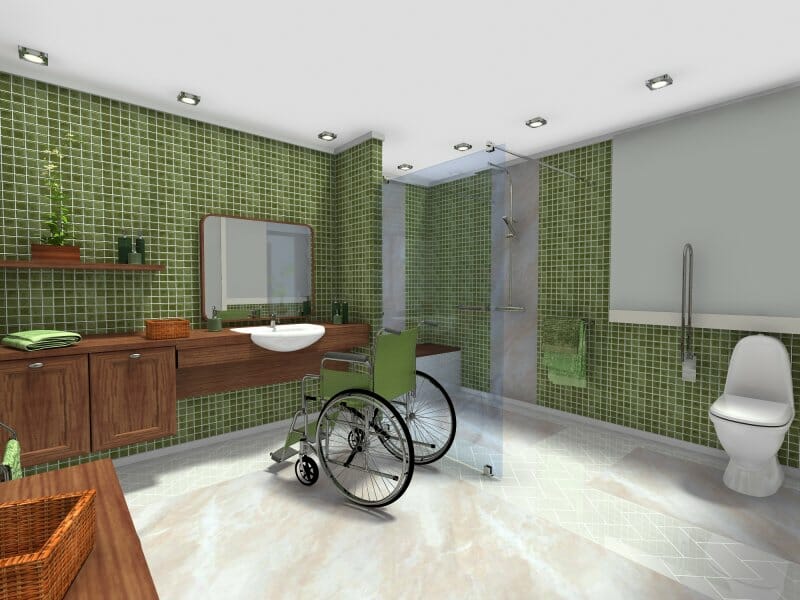When it comes to bathroom designs, accessibility is an often-overlooked aspect. However, accessible bathroom designs have gained significant importance in recent years. An accessible bathroom is more than just a space for convenience – it’s about creating an environment where people of all ages and abilities can feel safe, comfortable, and independent. Whether you are designing a new bathroom or remodeling an existing one, focusing on accessibility ensures that everyone can use the space with ease. In this article, we will explore the essential features, design considerations, and benefits of Accessible bathroom designs.
Understanding Accessible Bathroom Designs
Accessible bathroom designs prioritize functionality, safety, and comfort for individuals with physical disabilities, mobility limitations, or other health concerns. These designs are intended to make it easier for people to move around and perform tasks such as bathing, grooming, and using the toilet. Accessibility features include wider doorways, grab bars, non-slip flooring, and lowered sinks and countertops. The goal is to reduce obstacles and make the bathroom as user-friendly as possible, fostering independence and dignity for all users, regardless of their physical abilities.
An accessible bathroom can be designed for a wide range of users, from individuals with temporary mobility challenges to those who require long-term or permanent support. Therefore, it is essential to approach accessible bathroom design as an inclusive process, where every detail is carefully considered to ensure safety and ease of use for people with varying needs.
Importance of Proper Layout and Space Planning
The layout and space planning of an accessible bathroom play a significant role in its usability. One of the most critical aspects of layout is ensuring sufficient space for mobility, especially for individuals using wheelchairs, walkers, or other assistive devices. The bathroom should be designed with an open layout that allows for easy navigation. To achieve this, it is essential to provide a turning radius of at least 5 feet, which enables individuals to move around without obstacles.
The placement of essential bathroom fixtures should be thoughtfully planned. For example, the toilet should be positioned at a comfortable height for users, and the shower or bathtub should be easily accessible without the need for stepping over high edges. For those with limited mobility, walk-in showers or roll-in showers are excellent choices. Additionally, it’s essential to ensure that the bathroom floor is smooth and free of barriers, allowing users to move with ease.
Incorporating Grab Bars for Safety
One of the most important safety features in an accessible bathroom design is the installation of grab bars. These bars provide support for individuals when getting in and out of the bathtub, shower, or toilet. Grab bars should be installed at appropriate locations, such as beside the toilet, inside the shower or tub area, and near the sink, depending on the user’s needs. It’s essential to ensure that the grab bars are securely fastened to the wall and can support the weight of the user.
Grab bars come in various styles and materials, including stainless steel, chrome, and plastic-coated options. While the primary purpose of grab bars is safety, they can also complement the bathroom’s overall design. Choosing grab bars that match the style of the bathroom ensures that safety doesn’t compromise aesthetics. Additionally, ergonomic grab bars with non-slip surfaces can further enhance safety and comfort.
Designing for Easy Access to Fixtures
An accessible bathroom design should focus on making fixtures such as the toilet, sink, and shower easily accessible to everyone. For example, the toilet should be installed at a height that accommodates people who may have difficulty sitting down or standing up from a lower position. Toilets with raised seats or comfort-height models are particularly useful for individuals with limited mobility.
Sinks and countertops should be lowered to accommodate wheelchair users. Ideally, the sink should be mounted at a height where a person seated in a wheelchair can easily reach it. The use of open-space cabinetry beneath the sink ensures that wheelchair users have enough space to move their legs comfortably. Additionally, faucets should be easy to operate, with lever handles or motion sensors being excellent choices for people with limited hand strength.
Non-Slip Flooring for Enhanced Safety
Safety should always be a top priority when designing an accessible bathroom. Non-slip flooring is one of the most effective ways to prevent accidents in wet areas. Smooth surfaces can be slippery, especially when they are wet, leading to an increased risk of falls and injuries. Non-slip tiles, rubber, or vinyl flooring are great options for an accessible bathroom, as they provide traction and reduce the risk of slipping.
In addition to slip-resistant flooring, consider using materials that are easy to clean and maintain. Bathrooms are high-moisture areas, and materials that absorb water or require excessive maintenance can pose additional challenges. For example, porcelain or ceramic tiles with textured finishes provide both safety and ease of cleaning. When selecting flooring materials, it’s essential to balance both functionality and aesthetics to create a bathroom that is safe, beautiful, and easy to maintain.
Installing a Walk-In Shower or Bathtub
The shower or bathtub is often the most challenging aspect of designing an accessible bathroom. For individuals with mobility limitations, the traditional bathtub with a high side or a shower with a raised threshold can be difficult or impossible to access. Installing a walk-in shower or roll-in shower is an excellent solution, as these options allow for easy entry without having to step over any barriers.
Walk-in showers typically feature low or no thresholds, making them accessible for people with mobility aids. Additionally, grab bars should be installed inside the shower to provide additional support. For individuals who prefer to bathe rather than shower, a freestanding bathtub with a low or no lip may be a better option. However, it’s important to ensure that the bathtub’s sides are not too high, allowing users to get in and out with ease.
Enhancing Lighting and Visibility
Good lighting is essential in any bathroom, but it becomes even more important in accessible bathroom designs. Proper lighting ensures that all areas of the bathroom are visible, reducing the risk of accidents or injury. Consider using bright, even lighting throughout the space to provide clear visibility. Task lighting should be placed near the sink, toilet, and shower areas to improve the visibility of key fixtures.
Additionally, ensure that lighting is accessible and easy to operate. For instance, installing light switches at lower heights allows people with disabilities to control the lighting easily. Motion-sensor lights can be a great addition, especially in areas where the user may have difficulty reaching the switch. Dimmable lights also offer flexibility, allowing users to adjust the lighting to their preference.
Environmental Considerations for Sustainable Bathrooms
Accessible bathroom designs can also be environmentally friendly by incorporating energy-efficient and water-saving fixtures. Low-flow toilets, faucets, and showerheads are essential for conserving water while still providing optimal performance. These fixtures are particularly useful in reducing water waste and minimizing energy costs over time.
In addition to water-saving fixtures, consider using eco-friendly materials in the bathroom, such as sustainable wood, recycled tiles, and low-VOC paints. These materials contribute to a healthier indoor environment and promote sustainability. Creating a bathroom that is both accessible and environmentally conscious is a great way to reduce your carbon footprint while enhancing the bathroom’s functionality.
Conclusion
Accessible bathroom designs are crucial for creating spaces that are safe, functional, and comfortable for individuals of all abilities. By incorporating thoughtful design elements such as spacious layouts, grab bars, non-slip flooring, and accessible fixtures, you can ensure that the bathroom is a place where everyone can feel comfortable and independent. Whether you are remodeling an existing bathroom or building a new one, accessible design should be a priority to promote inclusivity and ease of use for all.
As more people recognize the importance of accessibility in home design, the demand for inclusive bathrooms continues to grow. By adopting accessible bathroom features, you not only enhance the functionality of your space but also create a welcoming environment that meets the needs of every member of the household. Ultimately, an accessible bathroom is a space where safety, comfort, and style seamlessly blend to create a truly functional and beautiful area.




